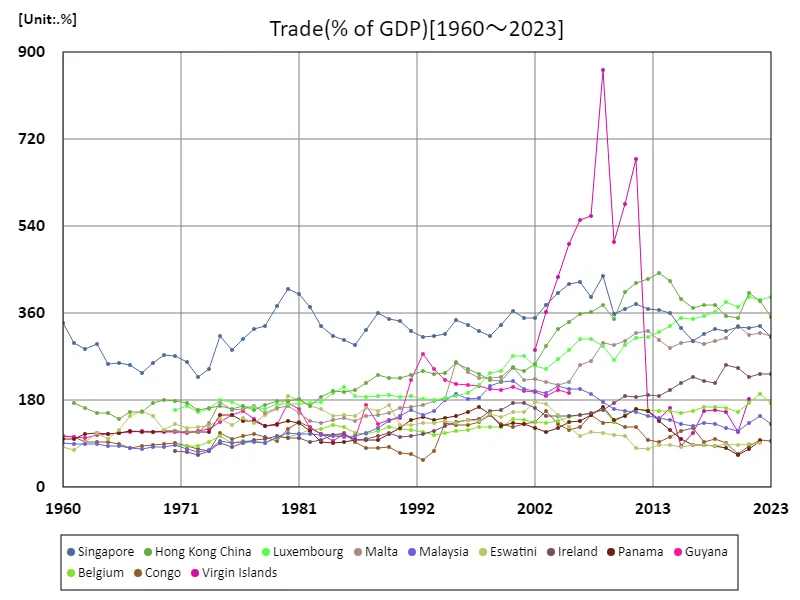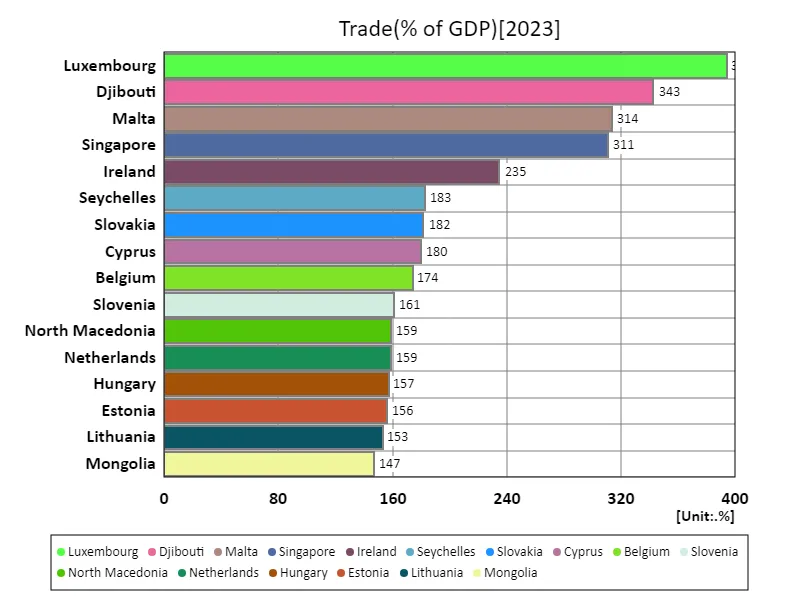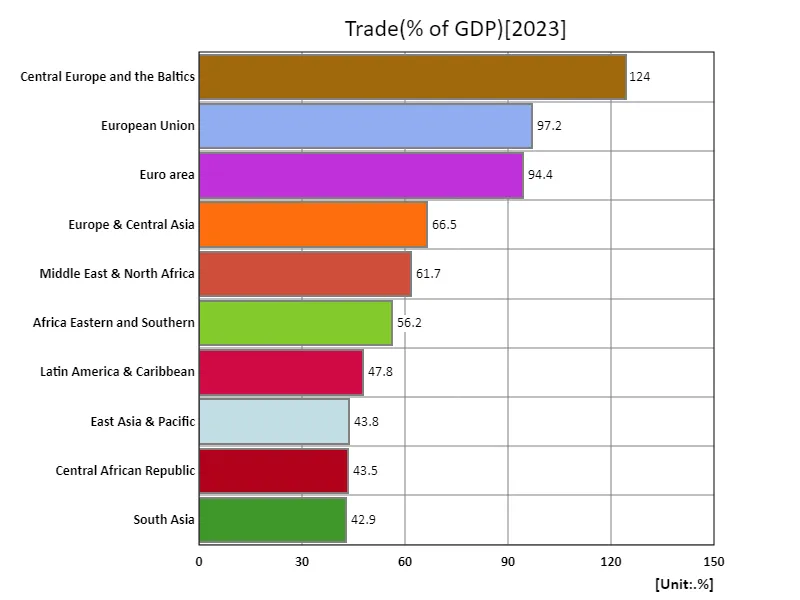Abstract
Trade (% of GDP) is an indicator of the importance of trade in a country’s economy, and the ratio is particularly high in small, highly internationalized economies such as Luxembourg. Luxembourg’s trade (as a percentage of GDP) reaches 394% in 2023 data, indicating that the country’s economy is highly dependent on external trade. Looking at historical trends, countries with high trade (as a percentage of GDP) generally have small economies and are geographically dependent on trade. For example, Singapore and Hong Kong also have high ratios, and these countries function as international financial centers and trade hubs. In contrast, large countries and large landlocked countries tend to have relatively low trade (as a percentage of GDP). In addition, trade (as a percentage of GDP) fluctuates depending on a country’s economic structure and strategic positioning. Small or neutral countries, or countries that serve as international logistics hubs, tend to have higher ratios because trade accounts for a large proportion of their economic activity. In contrast, in larger economies, the ratio is relatively lower due to the size of their domestic markets. This trend remains consistent even in today’s world of increasing globalization and economic internationalization.
Trade (as a percentage of GDP)
Considering trade (% of GDP) data from 1960 to 2023, the extreme value of 863% recorded by the Virgin Islands in 2008 indicates that the country’s economy was highly dependent on trade. This peak was driven by the Virgin Islands’ role as an international financial centre, attracting a large influx of foreign businesses and investment. However, by 2023, this ratio has fallen to 21.2%, which could be due to changes in the economic structure, reduced international financial inflows, or regulatory changes. As a general rule, trade (as a percentage of GDP) is very high in small countries and international financial centers, and by contrast is often relatively low in larger economies. From the 1960s to the present, the progress of globalization has caused many countries to become increasingly dependent on trade, but at the same time, there are also countries where their trade (as a percentage of GDP) has stabilized or declined due to economic diversification and the expansion of their internal markets. In addition, international financial crises and changes in economic policies can also affect trade (as a percentage of GDP), and fluctuations due to external factors are particularly significant in smaller economies. In this way, it can be said that trade (as a percentage of GDP) is strongly related to a country’s economic strategy and international position.


The maximum is 863%[2008] of Virgin Islands, and the current value is about 21.2%
Trade (GDP ratio) (worldwide)
Looking at data from 1960 to 2023, Singapore’s trade (as a percentage of GDP) recorded a high of 437% in 2008. This peak reflected a period when Singapore was rapidly growing as a trade and financial hub in Asia. However, the current decline in the ratio to 71.2% is likely due to structural changes in the economy and market maturity. The reason behind Singapore’s high trade (as a percentage of GDP) is that the country’s economy is extremely dependent on international trade. Singapore has seen thriving trade activity thanks to its well-equipped port facilities, logistics and financial services. The recent decline is due to a growing domestic market, economic diversification and increased international competition. Overall, trade (as a percentage of GDP) is higher in small countries and trade-dependent economies, with peaks in countries that are particularly dependent on international trade. However, as the economy develops and the internal market becomes stronger and more diversified, this ratio tends to decline. The case of Singapore illustrates the process of shifting from trade dependence to domestic demand leadership, reflecting the influence of global economic trends and domestic policies.


The maximum is 437%[2008] of Singapore, and the current value is about 71.2%
Trade (% of GDP) (worldwide, latest year)
Looking at data for 2023, Luxembourg’s trade (as a percentage of GDP) is at a very high level of 394%, while the global average is 93.5%. Luxembourg’s high ratio indicates that the country is an international financial and trade centre and its economy is highly dependent on external trade. As a general rule, trade (as a percentage of GDP) tends to be higher in small, highly internationalized economies, especially those specializing in finance and trade. On the other hand, larger countries and those with extensive domestic demand tend to have relatively low ratios. For example, countries such as Luxembourg and Singapore have high ratios due to their importance to international trade, while larger economies such as the United States and China have lower ratios. Additionally, the figure of 12,600% for the world’s total trade (as a percentage of GDP) is the result of tallying up the trade activity of all countries. This indicates that many countries are stimulating their economies through trade activities and reflects the contribution of international trade networks to economic growth. As such, trade (as a percentage of GDP) varies greatly depending on a country’s economic size and international position, and is an important indicator of the degree of economic internationalization and its dependence on trade.


The maximum is 394% of Luxembourg, the average is 93.8%, and the total is 12.6k%
Trade (% of GDP) (region, latest year)
The 2023 trade (% of GDP) data shows notable differences in trade dependence across regions. The high level of trade between Central Europe and the Baltic countries (as a percentage of GDP) of 124% is due to the fact that these regions have trade-dependent economies and function as part of international supply chains. The ratio tends to be high, especially in smaller economies with more active interregional trade. On the other hand, the world’s average trade (as a percentage of GDP) is 67.9%, which indicates that while many countries are somewhat dependent on trade, overall it is not that high. This average reflects the fact that the economies of developed and emerging countries are developing while balancing international trade and domestic demand. The overall total trade (as a percentage of GDP) figure of 679% is the result of adding up the trade activity of all countries. This shows that international trade is deeply embedded in national economies and a large proportion of economic activity is trade-related. Historically, small, trade-dependent countries have tended to have high trade (as a percentage of GDP) and larger, domestic demand-driven economies have tended to have relatively low trade. In addition, as globalization progresses, the importance of trade is increasing, and many countries are


The maximum is 124% of Central Europe and the Baltics, the average is 67.9%, and the total is 679%



Comments